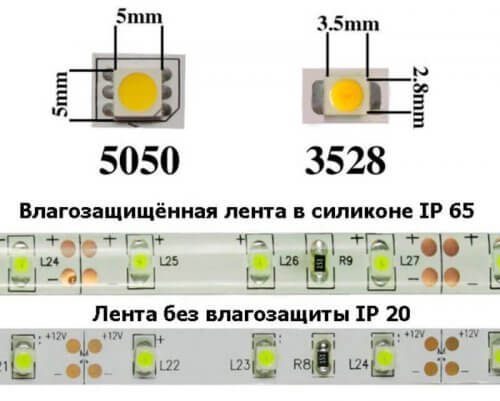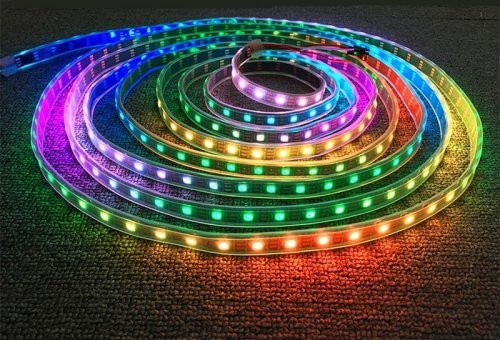What are the types of LED strips
What is LED strip
LED strip is a flexible printed circuit board with LEDs and current-limiting resistors located on it on one side and an adhesive layer on the back. This allows you to mount it in hard to reach places. The compact size and flexibility provide the ability to repeat complex geometric shapes for widespread use. They can be mounted on the ceiling, on the facade of the building or to make lighting for furniture, etc.
Modern industry produces tapes that have found application in various fields:
- illumination of goods in shop windows;
- light design of banners;
- room decoration - lighting of cabinets, a workplace in the office, for the kitchen, lighting design of shelves, stairs, niches;
- illumination of flowers and plants in winter or as the main lighting, stimulating the growth of seedlings in greenhouses;
- decoration of the relaxation room, sauna;
- illumination of rooms when watching TV at night or additional illumination of the workplace (LED strip evenly illuminates the space, does not give shadows, which is good for repairs and needlework);
- for the street apply moisture-proof tapes;
- the use of super bright LEDs allows them to be used in home lighting fixtures.
Explanation of symbols
A marking is applied to the tape, in which all the necessary information is encrypted. Suppose it has the form - "NLS-5050RGB60-14.4-IP20-12V-Pro R5" the most important information in it is decrypted like this +:
- 5050 - type of LEDs SMD 5050 (LEDs for surface mounting in a 5 x 5 mm SMD package);
- RGB - multicolor;
- 60 - on the tape 60 LEDs per 1 linear meter (pcs / m);
- 14.4 - power section length of 1 meter 14.4 watts;
- IP20 - dust and moisture protection class provided by the shell;
- 12V - supply voltage.
The remaining letters and numbers represent a series or designation of a particular product, and each manufacturer has their own.
Varieties of LED strips
LED strip is available in several types:
- Mono or plain. The most common products are in seven colors - red, blue, yellow, green, white, orange, pink. White light can be neutral, cold or warm, which is referred to as the color temperature in degrees Kelvin.
- Multicolor RGB. Allow you to get a variety of colors and shades.Either three separate red, blue, and green LEDs or type 5050 LEDs are mounted in the crystal — each of them has 3 crystals for each color. Mixing colors with different light intensities allows you to get almost the entire color gamut.
- RGBW or RGBWW - multi-color with one (W) or two channels (WW) in white. At the same time, white LEDs can emit a warm neutral or cold glow (depending on the tape, specify when choosing and ordering). If there are two “white” channels (WW), then it is usually cold and warm white.
A separate type of highlight address LED strip. They can be used to control each LED individually. You can create the effect of running fire in different colors or even make a matrix to display labels or pictures.
LED strips are also distinguished by the quality of the LEDs used, depending on this, manufacturers label them as "economy", "luxury", "premium", etc.
A less common type of LED strip is the side glow. The LEDs are installed on them so that they shine to the side, which allows you to make the backlight contour, for example, as required in the "angel eyes" for cars.
Characteristics and classification
LED strips come in different types, they are distinguished by a number of parameters:
- By the level of supply voltage. Or, as the people say, "by voltage." The most common products that operate 12 volts DC, in second place - 24V. Less common are 5 and 36 volts. In addition to the above, types of LED strips that operate on AC 220V without a power supply are popular. They connect to the network through a small adapter, inside of which is installed diode bridge. There are also battery-powered LED strips. They are usually powered by 3 “finger” AA or AAA batteries.
- By type of LEDs. Their marking is four-digit and usually reflects the overall dimensions of the element, which are indicated by a four-digit number, for example: 5730 - case size 5.7x3.0 mm, 5050-55x5 mm, 3528 - 3.5x2.8 mm, etc. They differ in luminous flux (in brightness) and power consumption.
- By the power and the number of LEDs - it depends directly on the previous paragraph. Typical values are 3.6, 7.2, 14.4 watts per meter.
- By the color of the glow (described in detail above).
- IP protection against dust and moisture provided by the shell. The first digit indicates dust protection. Takes a value from 0 to 6. The second shows the degree of protection against moisture 0 - not protected, 8 - can be used under water. For example, IP20 protection class says that there is no protection against dust, moisture and mechanical stress. IP33 - protected from dust and large particles larger than 2.5 mm and from splashing water (from rain) falling at an angle of 60 °. IP68 - has good protection against dust and can work under water. This type of product is used to decorate small fountains, pools, aquariums or used as street lighting for houses.
There is no classification of LED tapes "by application", since the ability to use the tape in certain conditions depends on the voltage and the dust and moisture protection class necessary to ensure electrical safety.
 The luminous flux is determined both by the characteristics of the diode and the number of them on the tape - the more of them, the greater the luminous flux.
The luminous flux is determined both by the characteristics of the diode and the number of them on the tape - the more of them, the greater the luminous flux.
 The tape can be cut, the multiplicity of the cut often depends on what voltage it is designed for. Products with 12V power can be cut into segments that are multiples of three LEDs, 24-volt - 6, 220-volt - 60 (it can differ, usually the multiplicity here is indicated in length: every 0.5 or 1 meter). The cut line is marked with a scissor symbol. We talked about this in more detail in the article: https://our.electricianexp.com/en/kak-mozhno-razrezat-led-lentu.html.
The tape can be cut, the multiplicity of the cut often depends on what voltage it is designed for. Products with 12V power can be cut into segments that are multiples of three LEDs, 24-volt - 6, 220-volt - 60 (it can differ, usually the multiplicity here is indicated in length: every 0.5 or 1 meter). The cut line is marked with a scissor symbol. We talked about this in more detail in the article: https://our.electricianexp.com/en/kak-mozhno-razrezat-led-lentu.html.
Advantages and disadvantages
LED strip has undoubted advantages over other light sources:
- Long service life, up to 50,000 hours.
- Low power consumption with high light output (usually 80-100 Lm / m).
- When decorating a room, it is possible to apply various color illumination. You can choose a narrow, wide or side glow ribbon if you need to make a luminous contour of something, for example, lighting for a stretch ceiling, niches made of drywall or other decorative elements.
- Resistance to mechanical damage. It can be operated in adverse conditions, used for lighting in the bathroom, etc.
- Available in various colors or white with different color temperatures - warm, neutral or cold glow.
- They are used for aquariums and for plants (phyto-tapes) in greenhouses, certain light waves allow you to quickly get a crop.
- Thanks to the adhesive base, it is easily mounted on any surface.
In addition to numerous advantages, it should be noted disadvantages:
- They are demanding on the quality of power supplies.
- RGB tapes require a special control controller.
- Powerful PSUs are expensive.
- Over time, the luminous flux decreases.
Conclusion
LED strip is an inexpensive and effective way to organize the illumination of the interior, architecture. 12-volt models are convenient to use for a car, namely for interior or bottom lighting, but in the latter case, according to the type of dust and moisture protection, it should be IP67-68.
 It is worth noting that in addition to flexible LED strips, there is another kind - rigid LED strips on an aluminum base, which provide a strong light flux and are often used for lighting.
It is worth noting that in addition to flexible LED strips, there is another kind - rigid LED strips on an aluminum base, which provide a strong light flux and are often used for lighting.
Now you know what types of LED strips are and the conditions for their use. We hope the information was useful and interesting for you!
Related materials:









